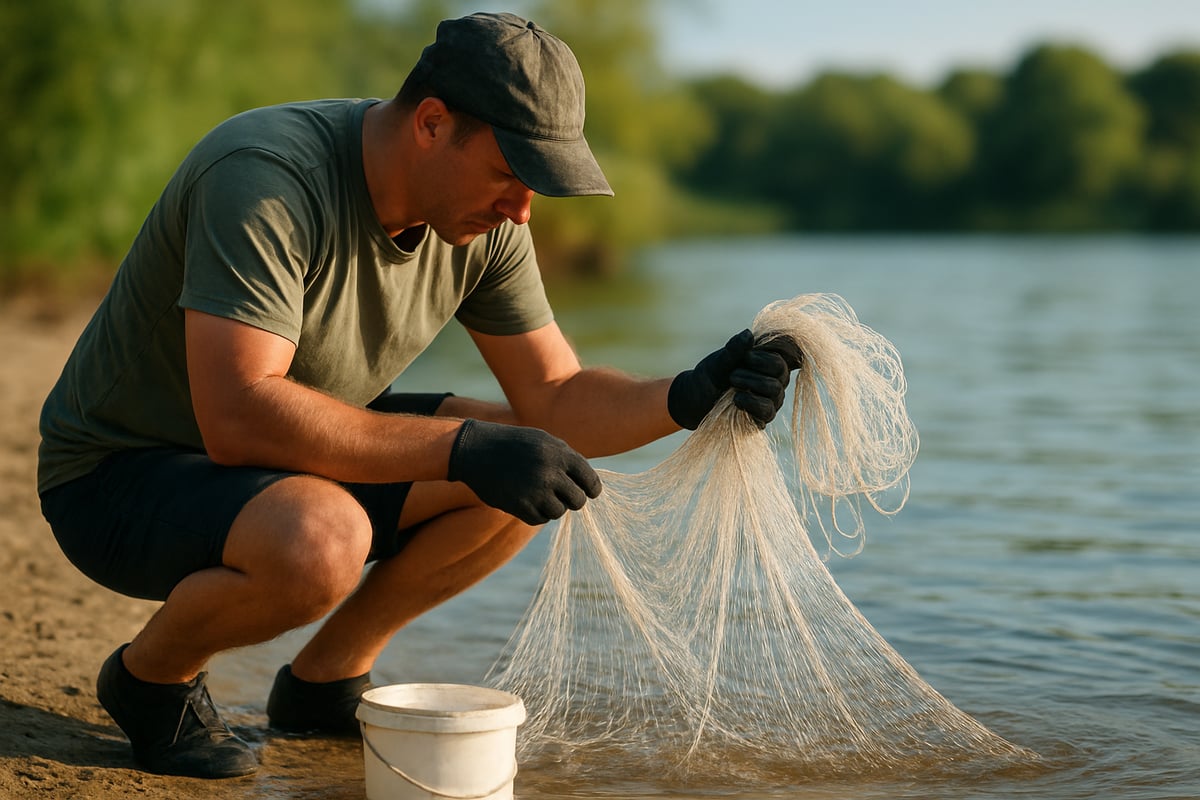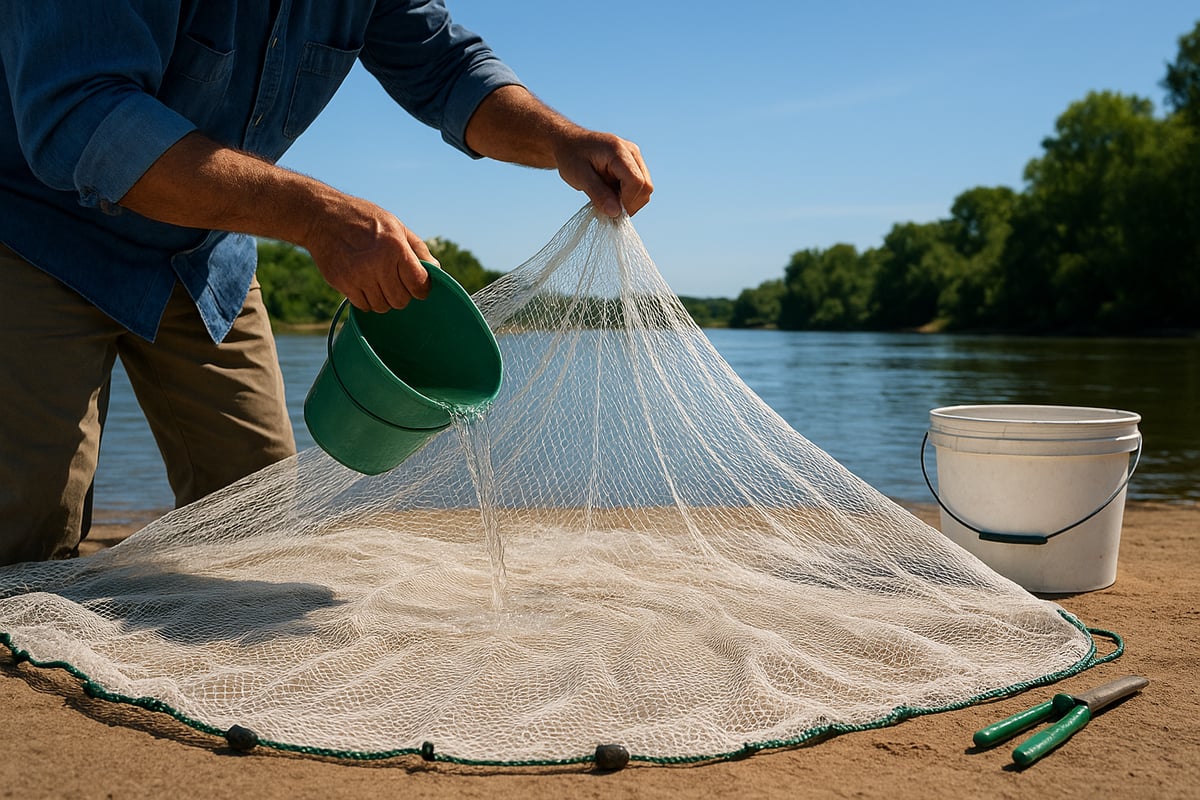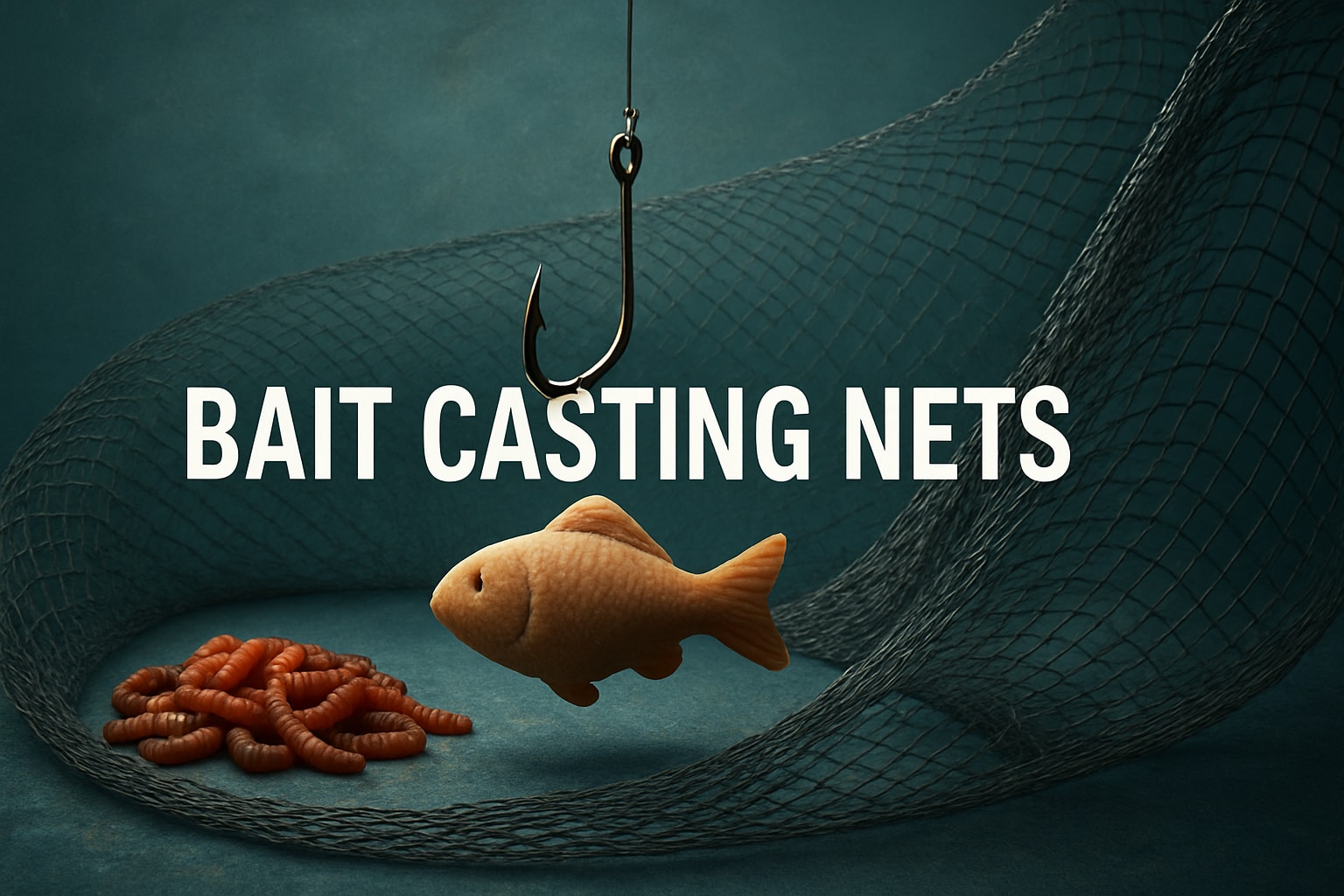Ready to catch more bait fish and elevate your angling results in 2025? This expert guide to bait casting nets reveals the proven strategies and latest advancements you need for success. Discover the essentials, step-by-step techniques, pro tips for every environment, and gear updates that will transform your fishing game. Whether you are new to bait casting nets or want to refine your skills, you will find practical advice and actionable insights inside. Dive in now and start mastering the art of bait casting nets for a more rewarding season ahead.
Understanding Bait Casting Nets: Types, Materials, and Key Features
Choosing the right bait casting nets sets the foundation for successful bait fishing. With so many options available, understanding the differences in types, materials, and modern features is essential for both beginners and seasoned anglers. This section will guide you through the essentials and help you make informed decisions for 2025.

What Are Bait Casting Nets?
Bait casting nets are circular fishing nets designed for catching live bait fish by throwing them over schools of fish and quickly drawing them closed. Unlike gill nets or seine nets, which passively trap fish or require dragging through water, bait casting nets are actively thrown and retrieved by hand.
These nets are commonly used from shorelines, boats, and estuaries, making them vital for both recreational and commercial fishers. A well-chosen net can significantly increase bait yield, saving time and effort on the water. For those new to bait fishing, exploring the Fishing Nets Information Page can offer a broader understanding of available tools and their applications.
Types of Bait Casting Nets
There are several primary types of bait casting nets, each suited for specific fishing environments and target species. The most common varieties are monofilament and multifilament nets. Monofilament nets are nearly invisible underwater, making them ideal for clear water conditions, while multifilament options offer enhanced strength and durability for rougher habitats.
Bait casting nets also come in hand-thrown and mechanical assist designs. Hand-thrown nets rely on the angler's skill, while mechanical assist models use a spring or lever system for easier deployment. Mesh size is another crucial factor, with smaller mesh targeting shrimp or small baitfish and larger mesh suited for bigger species.
Radius and diameter options range from compact 4-foot nets for tight spaces to expansive 12-foot nets for maximum coverage. Each type has pros and cons regarding ease of use, coverage, and effectiveness. For instance, a mono net excels in clear water where fish are wary, while a multifilament net is better for snag-prone areas.
Materials and Construction
The two most common materials for bait casting nets are nylon and polyethylene. Nylon nets are popular for their flexibility and resilience, offering a lifespan of up to five years with proper care. Polyethylene nets are lighter and more affordable, though they may not last as long, typically averaging three years.
Knotless netting provides a smooth feel and reduces injury to captured bait, while knotted netting offers added strength. The weight of the lead line is essential, as heavier lines sink faster and improve catch rates in deeper water. Construction quality directly affects casting efficiency—well-balanced nets with reinforced seams are less prone to tangling and easier to throw accurately.
| Material | Durability | Flexibility | Average Lifespan |
|---|---|---|---|
| Nylon | High | Flexible | 5 years |
| Polyethylene | Moderate | Less flexible | 3 years |
Investing in quality materials ensures your bait casting nets perform reliably across multiple seasons.
Key Features to Consider in 2025
The latest bait casting nets for 2025 incorporate several advancements designed to boost performance and comfort. Many modern nets feature anti-fouling coatings that prevent algae and debris buildup, as well as reinforced seams for greater durability.
Environmental considerations are increasingly important, with biodegradable materials and eco-friendly options now available. Ergonomic handles and improved wrist straps offer better control and reduce hand fatigue during repeated casts.
New regulations may impact net specifications, such as mesh size and allowable materials, so staying informed is crucial. Innovative features like quick-release mechanisms and lighter weights help anglers cast farther with less effort, ultimately increasing catch rates and minimizing strain.
Step-by-Step: How to Cast a Bait Net Like a Pro
Unlocking the full potential of bait casting nets begins with a clear process and attention to detail. Whether you are new to net fishing or refining your skills for 2025, following each step with precision will help you maximize your catch and protect your gear investment.

Preparing Your Net and Gear
Proper preparation is the foundation of success with bait casting nets. Start by laying out your net and inspecting it for any tears, broken lines, or tangled mesh. Damaged sections can significantly reduce your catch rate and may cause the net to fail at a critical moment.
Choose the optimal net size for your target species and fishing location. For example, a 6-foot radius net is suitable for small baitfish in tight estuaries, while an 8 to 10-foot net provides broader coverage on open shorelines. Ensure your gloves, bait buckets, and storage containers are within reach to streamline your workflow.
Safety should always be a priority. Check water depth and current strength before wading or casting. Look for underwater hazards, such as rocks or debris, that could snag your net. Use this pre-casting checklist for estuary fishing:
- Inspect net for damage or tangles
- Select appropriate net size for target bait
- Prepare gloves, buckets, and storage
- Assess water depth and current speed
- Scan for obstacles in casting area
By investing time in preparation, you increase the efficiency and lifespan of your bait casting nets.
Mastering the Casting Technique
Perfecting your casting technique is essential for achieving a wide, even spread with bait casting nets. Begin by positioning your feet shoulder-width apart, facing the target area. Hold the net by the horn with your dominant hand, letting the lead line rest in a neat coil.
For smaller nets, use a simple fold; for larger nets, consider a multi-step load to prevent tangling. The key steps are:
- Load the net by gathering it in both hands, ensuring the lead line is untwisted.
- Swing the net back gently, using your hips and shoulders for momentum.
- Release the net in a smooth, circular motion, aiming for a flat, pancake-shaped spread.
Common mistakes include releasing too early or late, resulting in an uneven spread or tangled mesh. Consistent practice is vital. According to fishing forums, anglers who practice regularly report a 30% higher success rate in bait collection.
For a deeper dive into advanced throws and visual demonstrations, check out this How to Throw a Cast Net guide, which complements these steps and showcases various techniques in action.
Retrieving and Handling Your Catch
Once your bait casting nets have settled on the waterbed, retrieval is all about minimizing bait loss and maintaining net integrity. Begin pulling in the handline steadily, keeping tension to prevent the net from bunching or snagging on underwater obstacles.
Lift the net gently to the surface, allowing the lead line to form a natural pouch. Avoid jerking movements that can dislodge or injure your catch. When removing bait from the net, work patiently to untangle shrimp, fish, or other species, reducing stress and injury.
Sort your bait promptly into designated containers. For best freshness, separate delicate species like shrimp from more robust baitfish to prevent damage. This method ensures your bait remains lively and attractive to target predators.
Attention to careful handling not only preserves your catch but also extends the working life of your bait casting nets.
Common Mistakes and How to Avoid Them
Several mistakes can hinder your success with bait casting nets. Overloading the net with too much bait or using a net size unsuited to your strength can make casting difficult and reduce spread.
Avoid casting against strong winds or in heavy currents, as this can cause the net to collapse mid-air or drift, missing the target zone. Neglecting regular net maintenance is another costly error; salt buildup and hidden tears can lead to lost bait and damaged equipment.
Here are key pitfalls to watch for:
- Overloading the net beyond recommended capacity
- Throwing in adverse wind or current conditions
- Skipping post-use rinsing and drying
- Ignoring small tears that grow into larger holes
Learning from real-world scenarios, many anglers have lost entire hauls by overlooking simple checks. Regular care and attention to detail ensure your bait casting nets perform reliably every trip.
Practice Drills for Improving Your Cast
Consistent practice is the fastest way to master bait casting nets. Start with onshore drills, using open space to perfect your grip, swing, and release. Employ small weighted objects to simulate the feel of a loaded net, focusing on accuracy and spread.
Video analysis is a powerful tool. Record your practice sessions to identify areas for improvement, such as timing or arm movement. Keep a log of your casting distance and spread, noting gradual improvements over time.
Suggested drills:
- Practice loading and throwing with different net sizes
- Use markers to gauge spread consistency
- Analyze video footage for common errors
- Set weekly goals for distance and accuracy
By tracking your progress and refining your technique, you will see measurable gains in your efficiency and effectiveness with bait casting nets.
Expert Tips for Bait Casting Net Success in Different Environments
Mastering bait casting nets requires adapting your approach to the unique challenges of each fishing environment. Whether you are casting from shore, a boat, or in low-visibility conditions, applying the right techniques will dramatically improve your bait yield and efficiency. Let’s explore expert strategies for every scenario.

Coastal and Shoreline Casting
Success with bait casting nets along the coast begins with understanding water movement. Tides influence bait fish location, so observe tidal shifts and aim to cast during incoming or outgoing tides for maximum results. Scan for schools near rocks, piers, or submerged structures, as bait tends to shelter there.
Adjust your technique based on water depth. In shallow water, use a net with a smaller radius for precise placement. For deeper spots, opt for a larger net and allow extra sink time. Early mornings often see higher bait activity compared to late afternoons, making them prime casting windows.
Key tips for shoreline casting:
- Watch for surface ripples indicating bait presence
- Avoid casting into heavy surf or strong crosswinds
- Use polarized sunglasses to spot schools more easily
With careful observation and the right bait casting nets, shoreline anglers can consistently outfish competitors.
Boat-Based Bait Netting
Casting from a boat introduces new dynamics. Safety is paramount, so ensure stable footing and communicate with your crew before every cast. When space is limited, choose a net size that allows full spread without tangling on gear or railings.
Coordinate with others on board for efficient retrieval and sorting. Using sonar or fish finders to locate bait schools will save time and increase your catch. When you spot a promising target, approach quietly and position the boat upwind for a controlled cast.
Best practices for boat-based bait casting nets:
- Assign roles for casting, retrieval, and storage
- Keep buckets and containers within easy reach
- Watch review videos, such as those in Fishing Net Review Videos, to see effective techniques in action
Boat netting is about teamwork and preparation, ensuring you maximize every opportunity.
Estuary and River Mouth Strategies
Estuaries and river mouths present ever-changing conditions. Currents can be unpredictable, so choose bait casting nets with appropriate lead line weights for faster sink rates in swift water. In narrow channels, use compact nets for greater control and accuracy.
Muddy or sandy bottoms may require adjustments in your retrieval speed to prevent snagging or excessive debris. Target bait fish like mullet by casting across current seams where fresh and saltwater mix, as these areas often hold the most life.
Tips for estuary netting:
- Cast upstream to allow the net to settle naturally
- Avoid overloading the net in areas with dense vegetation
- Adjust your technique for wind and current direction
With adaptive strategies, estuary anglers can consistently fill their bait tanks, even in challenging conditions.
Nighttime and Low-Visibility Tactics
Bait casting nets can be highly effective at night, as many target species become more active. Equip yourself with a reliable headlamp and consider nets featuring glow-in-the-dark markers for easier tracking. Move slowly and use caution to avoid accidents or spooking bait.
Slower retrievals reduce the risk of losing bait in darkness. Focus on areas where artificial lights attract schools, such as docks or bridge pilings. Data from night anglers shows a significant increase in catch rates during dusk and dawn hours.
Key considerations for low-visibility netting:
- Double-check your surroundings before casting
- Use reflective tape on your net for added visibility
- Target species known to school at night for higher yields
Patience and careful technique make nighttime bait casting nets a valuable tool in any angler’s arsenal.
Weather and Seasonal Adjustments
Weather plays a crucial role in bait fishing success. Strong winds and rain can reduce visibility and impact net spread, so seek sheltered areas and adjust your casting angle for better control. In cold conditions, bait fish may move deeper, requiring longer sink times and heavier nets.
Seasonal migrations affect bait availability. Research local patterns to identify peak months for your preferred species. For instance, pilchards often gather in large schools during spring in the Pacific, presenting ideal opportunities for skilled netters.
Seasonal and weather tips:
- Dress appropriately for changing conditions
- Rotate nets to avoid excessive wear during peak seasons
- Monitor local reports for real-time bait movements
By staying adaptable and informed, anglers can make the most of their bait casting nets year-round.
Maintenance, Care, and Longevity of Bait Casting Nets
Proper maintenance of bait casting nets is essential for maximizing performance and lifespan. A well-cared-for net not only increases your catch rates but also saves money and reduces environmental impact over time. Let us explore the most effective techniques to keep your bait casting nets in peak condition for every season.

Cleaning and Drying Best Practices
Keeping bait casting nets clean is the first step to ensuring longevity. After every saltwater trip, rinse your net thoroughly with fresh water to remove salt and debris. Allow the net to air dry in a shaded, well-ventilated area, as direct sunlight can weaken synthetic fibers over time.
Avoid leaving your net in a pile, as this can trap moisture and promote mold or mildew growth. Instead, hang the net spread out, using a line or hooks. This simple practice can prevent premature deterioration, as seen in cases where improper drying led to brittle, unusable nets within a year.
For more advanced cleaning techniques and best practices, consider reviewing the Best Management Practices for Net Pen Aquaculture, which outlines effective maintenance methods applicable to bait casting nets. Regular cleaning will keep your nets ready for action and extend their useful life.
Repairing and Storing Your Net
Timely repairs are crucial for maintaining bait casting nets in optimal condition. Inspect your net after each use, checking for tears, holes, or damaged lead lines. Small holes can be fixed with a DIY repair kit, while larger damage may require professional services.
Proper storage also plays a significant role. Fold your net loosely and place it in a breathable bag or bucket, avoiding tight knots that can cause tangling. Store the net in a cool, dry place away from direct sunlight to prevent UV damage.
A quick cost comparison:
| Repair Type | DIY Repair Kit | Professional Service | Net Replacement |
|---|---|---|---|
| Average Cost (USD) | $5–$15 | $20–$50 | $60–$150 |
Investing a little time in repairs and thoughtful storage can keep your bait casting nets performing at their best for years.
Extending Net Life: Pro Tips
Consistency in care routines will give bait casting nets a notable edge in longevity. Set a maintenance schedule to inspect for wear, especially at seams and lead lines. Applying protective sprays or anti-fouling treatments can shield your net from algae and barnacle buildup.
Rotate between multiple nets during busy seasons to distribute wear evenly. This approach has proven successful, as one angler reported their three-year-old net outperformed newer models simply due to regular maintenance and rotation.
By following these pro tips, you can keep bait casting nets in top shape, ensuring reliable performance and reducing the need for frequent replacements.
Eco-Friendly Disposal and Recycling
Sustainable practices should be part of every angler’s routine when it comes to bait casting nets. When a net reaches the end of its life, avoid discarding it in landfills or waterways. Instead, seek out local recycling programs or initiatives that accept used fishing nets.
Some communities, such as those in New Zealand, run net recycling drives to reduce marine litter. For detailed guidance on responsible disposal, refer to the Best Practices to Reduce Marine Litter, which covers sustainable disposal methods for fishing nets.
Choosing biodegradable or recyclable bait casting nets and participating in recycling initiatives helps protect marine environments for future generations.
Innovations and Trends in Bait Casting Nets for 2025
Advancements in bait casting nets are shaping the future of bait fishing, offering anglers new ways to maximize catch rates and minimize environmental impact. In 2025, both technology and consumer preferences are driving significant changes. Let’s explore the leading innovations and trends that will define bait casting nets this year.
Technological Advances in Net Design
Technology is revolutionizing bait casting nets. Manufacturers are integrating smart features like built-in sensors that monitor catch rates and net position. These sensors provide real-time feedback, helping anglers adjust their approach on the water.
Lightweight, high-durability synthetic materials are now standard, reducing fatigue and increasing casting efficiency. Customizable mesh sizes allow users to target specific bait species more effectively. For example, a 2024 product launch introduced a net with modular mesh panels and a digital catch counter, setting new standards for versatility.
Here’s a quick comparison of traditional vs. modern bait casting nets:
| Feature | Traditional Nets | Modern Nets (2025) |
|---|---|---|
| Materials | Nylon, Polyethylene | Advanced synthetics |
| Smart Sensors | No | Yes |
| Mesh Customization | Limited | High |
| Weight | Heavier | Lighter |
These advances ensure that bait casting nets are more efficient and adaptable than ever before.
Sustainability and Environmental Impact
Sustainability is at the forefront of bait casting nets innovation. The rise of biodegradable and recycled-material nets is reducing the ecological footprint of fishing. Many manufacturers now offer nets made from plant-based polymers that break down naturally, addressing the issue of ghost nets in marine environments.
Recent regulatory shifts are encouraging eco-friendly fishing practices. In fact, new policies in the Pacific have led to a measurable reduction in lost nets, with some regions reporting a 20% decrease in ghost net incidents over the past year.
Community-led initiatives, especially in the Pacific Islands, are promoting sustainable netting practices. These programs support the adoption of environmentally conscious gear and provide education about proper disposal. For anglers, choosing sustainable bait casting nets means contributing to the health of aquatic ecosystems.
Ergonomics and User Comfort
Modern bait casting nets are designed with the angler’s comfort in mind. Redesigned handles, wrist straps, and harnesses make casting easier and reduce strain during long sessions. Lighter, balanced materials help prevent fatigue, letting users fish longer with less effort.
User testimonials highlight the difference these ergonomic improvements make. Many report increased casting efficiency and less hand or shoulder discomfort, especially during high-volume fishing trips. Recent product reviews from 2024 praise the introduction of foam-padded grips and quick-adjust harnesses, describing them as game-changers for both novice and experienced anglers.
The focus on ergonomics ensures that bait casting nets are accessible and practical for a wide range of users, supporting better performance and enjoyment.
Market Trends and Consumer Preferences
The market for bait casting nets is evolving rapidly. There is a growing demand for locally made, high-quality nets that offer durability and versatility. Anglers are seeking multi-purpose nets capable of handling diverse bait species and fishing conditions.
Sales statistics from 2023 and 2024 show a sharp increase in the popularity of nets with quick-release features, which simplify handling and reduce bait loss. The shift toward specialized designs, such as those highlighted in the American Style Cast Nets Collection, reflects a preference for tailored solutions that combine performance with ease of use.
Additionally, comparisons between traditional and Japanese-style nets, like those found in the Japanese Style Cast Nets Guide, are informing consumer choices, allowing anglers to select the best bait casting nets for their specific needs.
With these trends, it is clear that bait casting nets in 2025 are not just tools, but essential investments for any serious angler. Staying informed about the latest innovations ensures you are equipped for success.
After exploring the practical steps, expert insights, and innovative trends in bait casting nets, you’re now equipped to make informed choices for your next fishing adventure. Whether you’re a seasoned angler or just starting out, having the right net can mean the difference between an average day and a truly successful catch. At Action Outdoors Limited, you’ll find high quality, New Zealand made fishing nets that meet the demands of every environment discussed in this guide. Ready to enhance your results and feed your family with confidence this season? Feed the Family

